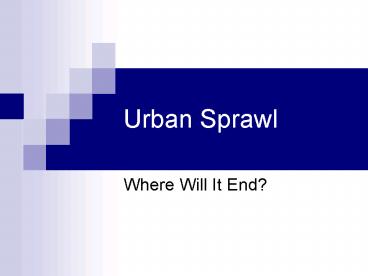Urban Sprawl - PowerPoint PPT Presentation
1 / 13
Title: Urban Sprawl
1
Urban Sprawl
- Where Will It End?
2
What do these areas have in common?
- Hickory Woods
- Partridge Farms
- Meadowlands
- What they have in common
- Houseslots of houses
- All are housing developments.
- Name after the types of land that were cleared in
order to build new homes. - No more woods, farms, or meadows.
3
(No Transcript)
4
(No Transcript)
5
(No Transcript)
6
Urban Developments
- For many decades, urban development around the
world and especially in the United States
Canada has been moving out from cities to
suburbs. - It is an area of housing built at the edge of a
city. - Developers create suburbs by buying up farmlands
or forested areas outside a city. - Used for housing tracts, shopping centers, and
office parks. - Only way to get there is through traffic-clogged
roads.
7
Problems
- Rapid and often poorly planned spread of cities
and suburbs is known as urban sprawl, where they
move outward into rural areas.
8
The Geographic Setting
- Smaller cities or towns with open land between
them and the central city are called exurbs. The
city, its suburbs, and exurbs link together
economically to form a functional area called a
metropolitan area. - A megalopolis is formed when several metropolitan
areas grow together. - Examples Boston, New York, Philadelphia,
Baltimore, and Washington, D.C. - Urbanization, the growth in the number of cities
and the resulting changes has occurred because
more people moved to cities to find work.
9
Land Use Patterns
- The land in cities is used for residential,
industrial, and commercial purposes. The core of
a city is almost always based on commercial
activity. The area of commercial activity is the
citys central business district (CBD) - Cities have various functions, including to
provide retailing, entertainment, transportation,
business, education, and government services.
Cities also often provide wholesaling,
manufacturing, residential, recreation,
religious, and social services.
10
Concentric Zone Model
- Urban core The older part of a city. CBD
- Urban fringe the ring of small towns and suburbs
that surround a big city. - Rural fringe the small towns, farms, and open
spaces that lie just beyond a citys suburbs.
11
The Concentric Zone Model The Concentric ring
model also known as the Burgess model is one of
the earliest theoretical models to explain urban
social structures. It was created by sociologist
Ernest Burgess in 1925.
12
Multiple Nuclei Model
- The multiple nuclei model is an ecological model
put forth by Chauncy Harris and Edward Ullman in
the 1945 article "The Nature of Cities." The
model describes the layout of a city. It notes
that while a city may have started with a central
business district, similar industries with
common land-use and financial requirements are
established near each other. These groupings
influence their immediate neighborhood. Hotels
and restaurants spring up around airports, for
example. The number and kinds of nuclei mark a
city's growth. - The theory was formed based on the idea that
people have greater movement due to increased car
ownership. This increase of movement allows for
the specialization of regional centers (eg. heavy
industry, business park). There is no clear CBD
in this type of model. - http//en.wikipedia.org/wiki/Multiple_nuclei_model
13
Sector Model
- The sector model also known as the Hoyt model was
proposed in 1939 by economist Homer Hoyt. It is a
model of urban land use and modified the
concentric zone model of city development. The
benefits of the application of this model include
the fact it allows for an outward progression of
growth however, like all models of urban form its
validity is limited. - http//en.wikipedia.org/wiki/Sector_model































